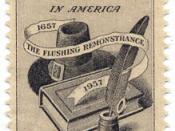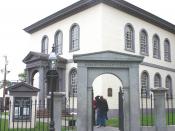The Struggle For Religious Freedom
The struggle for religious freedom was of course a big factor in the lives of colonists leading up to the 1700's. This issue was the most prevalent in the northern colonies because of the different strong beliefs of the religious groups that settled there. A main factor for moving to the colonies from England was to have religious freedom, but some ended up finding themselves in the same situation as before, living in a land with little or no religious tolerance because of the lack of open-mindedness and stubbornness of previous settlers. The land that was supposed to be religious freedom for all ended up being a place with little or no religious freedom and little tolerance.
Puritans in Europe were actually victims of religious persecution, and came to the colonies to get away from it. Although, upon their new found freedom they ended up enforcing the same non tolerant tactics onto other surrounding religious groups in the northern colonies which had once been enforced upon themselves in England.
Those who went against Puritan code were subject to capital punishment and expulsion from the colony. An example of this is Mary Dyer. She followed the teachings of Anne Hutchinson, who was America's first female religious leader. Due to this, Dyer in 1638 was forced to move to Rhode Island. Converting to the teaching of Quaker, she then proceeded to go back to Massachusetts to spread her beliefs. Upon doing this, she was arrested 3 times and finally hanged in 1660.
The Quakers were a religious group also trying to flee from European persecution. They were a humble yet proud people ardent in their beliefs, yet also tolerant to others. Their leader was a man by the name of William Penn. He was a Quaker missionary.



This isnt everything
a very brief and slightly repetitive essay on what is a very complex subject, they also left to escape the poverty and famine in there own countrys.but you have done a little research and whats here is good.
5 out of 5 people found this comment useful.